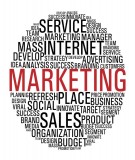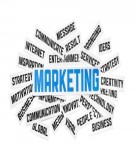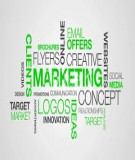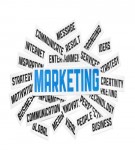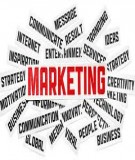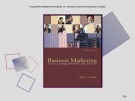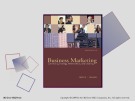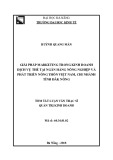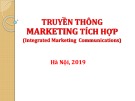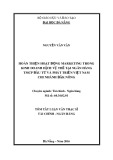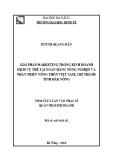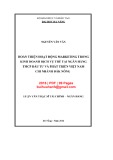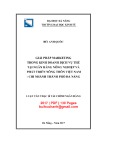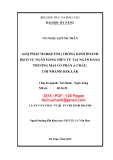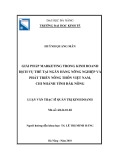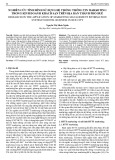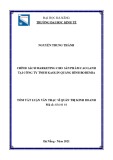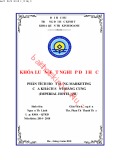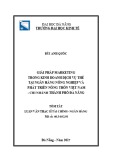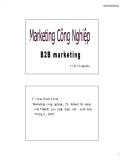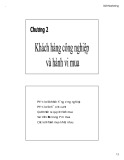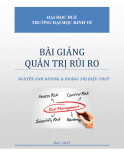1/2/2017
Chapter 1 Introduction to Business Marketing
www.dinhtienminh.net
DINH Tien Minh (Ph.D.) University of Economics HCMC
Understand Business Market and Business Marketing.
the differences between B2B and
Distinct B2C.
Know the different kinds of demand in Business Market.
Objectives
2
Content
1.1 Concepts of Business Market
1.2 Concepts of Business Marketing
1.3 Demands of Business Market
1.5 Homework
1.4 Conceptual Questions
3
1
1/2/2017
What is Business Market?
1.1. Concepts of Business Market
Krishna K Havaldar (2010), Business Marketing, McGraw Hill, 3rd edition, p1.
All of the organisations who buy goods and/or services for producing their own goods and/or services.
4
Business organizations include:
1.1. Concepts of Business Market (cont’)
Commercial market:
the Firms that acquire products indirectly, to support, directly or production of other goods and services. This is the largest segment of the business market. Trade industries: Retailers or wholesalers that purchase products for resale to others.
5
1.1. Concepts of Business Market (cont’)
Business organizations include (cont’):
Government: all domestic levels (federal, state,
local) and foreign governments.
Public and private institutions: such as hospitals, churches, colleges and universities, and museums.
6
2
1/2/2017
Characteristics of Industrial Market:
1.1. Concepts of Business Market (cont’)
• Business market is more concentrated than consumer market and becomes less geographically concentrated as Internet technology improves.
Geographic market concentration
• Business market has smaller number of buyers than
consumer market.
• Many buyers are large organizations, such as Boeing,
which buys jet engines.
Sizes and number of buyers
7
Characteristics of Industrial Market (cont’):
The purchase decision process
• Sellers must navigate organizational buying processes
that often involve multiple decision makers.
• Purchasing process is usually more formal
than in and may require bidding and
consumer market negotiations.
Buyer-seller relationships
• Often more complex than in consumer market.
• Greater reliance (trust) on relationship marketing.
1.1. Concepts of Business Market (cont’)
8
1.1. Concepts of Business Market (cont’)
Characteristics of Industrial Market (cont’):
Evaluating international business markets
• Business purchasing patterns differ from country to
country.
• Global sourcing purchasing goods and services from
suppliers worldwide.
– Can bring significant cost savings but requires adjustments.
9
3
1/2/2017
Customer value in Business Markets:
The economic, technical, service and social benefits received by a customer firm in exchange for the price paid for the product or service offering.
Anderson and Narus, Business Market Management, Pearson Education, 2nd edition, p5-9.
A ratio between what the customer gets (functional and emotional benefits) and what he gives (monetary, time, energy cost).
Philip Kotler, Marketing Management, Prentice Hall India, 11th edition, p11-12.
1.1. Concepts of Business Market (cont’)
10
Customer value in Business Markets (cont’):
1.1. Concepts of Business Market (cont’)
• Focus group
• Customer interview
• Internal test (conduct laboratory test)
Accurately estimating value would help the supplier firms to create and deliver value to targeted market segments and customers. Here are some methods:
11
1.2. Concepts of Business Marketing
What is Business Marketing?
R
S.T.P
MM
I
C
12
4
1/2/2017
Product
Place
Marketing Mix
Personal selling
Advertising
Price
C/T Promotion
Press Meeting
Promotion
Direct Marketing
Event/ Launching
PR
Charity/ Sponsor
Crisis
Evaluation
1.2. Concepts of Business Marketing (cont’)
13
What is Business Marketing? (cont’)
1.2. Concepts of Business Marketing (cont’)
Companies also buy services,
such as
legal,
Organizational sales and purchases of goods and services to support production of other products, to facilitate daily company operations, or for resale.
Lau Geok Theng (2007), Business Marketing – An Asian Perspective, McGraw Hill, p3.
accounting, office-cleaning, and other services.
14
1.2. Concepts of Business Marketing (cont’)
The importance of Business Marketing
The business market occupies several layers of the value chain in comparison to the consumer market, which often occupies one layer.
Metal plastics
Electronic components
Printed circuit boards
Televisions Computers
• Consumer
• Business market
• Business market
• Business market
market • Business market
Lau Geok Theng (2007), Business Marketing – An Asian Perspective, McGraw Hill, p4.
15
5
1/2/2017
Differences between B2B & B2C Marketing:
Krishna K Havaldar (2010), Business Marketing, McGraw Hill, 3rd edition, p5.
1.2. Concepts of Business Marketing (cont’)
16 16
Differences between B2B & B2C Marketing:
Krishna K Havaldar (2010), Business Marketing, McGraw Hill, 3rd edition, p5.
1.2. Concepts of Business Marketing (cont’)
17 17
1.2. Concepts of Business Marketing (cont’)
B2B distribution channels:
Krishna K Havaldar (2010), Business Marketing, McGraw Hill, 3rd edition, p7.
18 18
6
1/2/2017
B2C distribution channels:
Krishna K Havaldar (2010), Business Marketing, McGraw Hill, 3rd edition, p7.
1.2. Concepts of Business Marketing (cont’)
19 19
1.3. Demands of Business Market
The demand for industrial products and services does not exist by itself. It is derived from the ultimate demand for consumer goods and services.
Derived demand
Fluctuating demand
Stimulating demand
Industrial demand
Joint demand
Cross-elasticity of demand
Krishna K Havaldar (2010), Business Marketing, McGraw Hill, 3rd edition, p9.
Inventory adjusment
20
1.3. Demands of Business Market (cont’)
Derived demand
The linkage between demand for a company’s output and its purchases of resources such as raw machinery, materials.
components, supplies, and
Example: The demand for precision steel tubes does not exist itself. It results from demand for bicycles, motorcycles, scooters.
21
7
1/2/2017
Fluctuating demand
1.3. Demands of Business Market (cont’)
Derived demand creates volatility. Demand for industrial products fluctuate more than the demand for consumer goods.
Example: In India, in 1986, due to recession in bicycle industry, the demand had fallen by 40%. This resulted in the drop in demand for precision steel tubes by 70%.
22
Stimulating demand
1.3. Demands of Business Market (cont’)
Demand for industrial products is derived from ultimate demand for consumer goods.
directly
reach
that
the
campaigns consumers.
Business marketers should carry out promotional ultimate
Example: Intel was stimulating the demand for their microprocessor by making customers of personal computers aware and more interested by “INTEL INSIDE” in their advertising.
23
1.3. Demands of Business Market (cont’)
Joint demand
Occurs when one industrial product is useful if
the electrical motor
if
other products also exist. Example 1: Electrical Panel Builder needs complete set of components.
Example 2: A pump set can not be used for pumping water, is not available. Crompton Greaves circumvented the influence of joint demand by designing the mono- bloc pump set.
24
8
1/2/2017
Cross-Elasticity of demand
1.3. Demands of Business Market (cont’)
change in price (inelastic – unitary – elastic).
10
9
8
7
Elasticity is simply the change in demand from a
Elastic
6
Inelasti c
B
A
5
P
4
3
2
1
0
15
20
2
6
11
12
14
16
17
18
19
8
10
1
3
4
5
7
13
9 Q (units)
Krishna K Havaldar (2010), Business Marketing, McGraw Hill, 3rd edition, p10.
25
Inventory adjustments
1.3. Demands of Business Market (cont’)
(JIT) Just-In-Time inventory policies
Inventory adjustments are also vital to wholesalers
boost efficiency by cutting inventory and requiring vendors to deliver inputs as they are needed.
and retailers.
26
1.4. Conceptual questions
1. Explain
the major
between
differences consumer and industrial marketing?
2. Define value in business markets. What methods are used to estimate customer value? 3. Explain with an example why industrial
demand is called derived demand.
27
9
1/2/2017
1.5. Homework
2. Out of the various differences between industrial and consumer marketing, which characteristics would have maximum impact on development of an industrial pump marketing strategy for manufacturer? Give reasons.
1. the Illustrate how a company can circumvent influence of joint demand.
3. Construct a customer value proposition for a company known to you. Explain how would you demonstrate and document the customer value.

